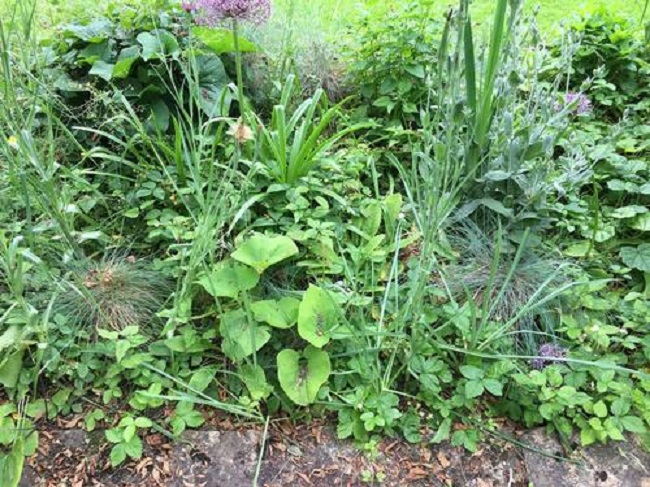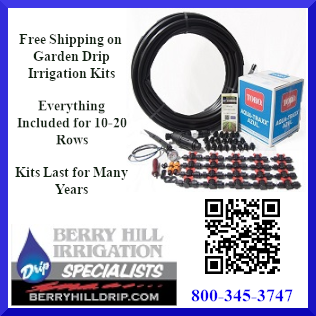
Any weed, can be become a serious problem if left unchecked. Any one seed from a weed can settle in nearly any type of soil and entrench itself for up to six years before it sprouts and matures. Now, when it comes to getting rid of these garden nuisances, there is no one “magic bullet” method to controlling weeds in your garden. A combination of tactics must be used to ensure that a garden is not blemished by unsightly weeds. The following are examples of different treatment options available for tackling a weed invasion or just trying to prevent one from happening in the first place.
Crowd Them Out
A solid first idea is to try to crowd out the weeds. A busy and healthy garden is a wonderful start to deterring weeds. Weeds are a bit opportunistic in that they’ll try to take root in any unused real estate in your garden. By keeping your garden comfortably crowded you will give very little room for the weeds to settle in. Plus, a healthy tall garden will block out a majority of the available sunlight for those little weeds that are still budding, thus cutting them off from a major resource at a vital part of their development.
Get Them Drunk
It is possible to get rid of a weed problem in a garden by dousing vodka on the weeds. This little cocktail will “waste” any weed that manages to find itself in a garden. The explanation behind this odd solution is that vodka acts as a desiccant agent on a plant; thus, when it’s sprayed on a weed, vodka will dry out the plant in a matter of hours. This concoction does not discriminate from plant to plant, so take the time to cover the vegetation that you do want to keep around and spray with care. Find plastic spray bottle and brew yourself a homemade weed killer. The recipe varies from source to sources but here’s an example of a popular variation:
- One ounce of vodka
- Two cups of water
- Two teaspoons of dish soap
Let Them Read the Newspaper
The veteran gardeners have all probably heard of the “newspaper” trick but may not have tried it. The idea here is to literally smother the weeds to death with the use of newspaper and mulch. The process goes something like this:
- Cover a weed infested area with sheets of newspaper
- Douse the newly laid newspaper with water so that it stays heavy on the soil
- Sprinkle one or two inches of mulch on the newspaper
This effectively cuts off all sunlight from the weeds. The neat thing about the newspaper trick is that there is no clean up afterwards. The weeds beneath the newspaper die plus the newspaper will decompose into the soil and help nourish it. A word of caution, some weeds can be stubborn when it comes to this method and can potentially grow through the newspaper and mulch barrier. Multiple uses of this trick may be required.
Give Them Some Corn
A corn by-product, corn gluten meal can stop seeds from maturing into full-fledged weeds. Corn gluten meal is a natural pre-emergent herbicide substitute that kills seedlings as they germinate. Corn gluten meal contains protein from the corn so, it poses no health risk to humans or animals when used as an herbicide for weeds that are invading a garden.
Herbicides
Pre-emergent herbicides generally must be applied and watered in before weed seeds germinate and corn gluten is no exception. Since the meal will prevent germination, spread it around established weeds in the garden, and after seedlings and transplants have taken hold in the soil. Spread the meal once more to minimize the chances of late-season weeds popping up.
Herbicides should never be the first choice when it comes to weed control because of the risk they can pose to a garden’s other plant life. But the use of herbicides (when handled appropriately) is still the single most effective method of managing a weed problem.
There are 2 major types of general-purpose herbicide: pre-emergence herbicide and post-emergence herbicide.
Pre-Emergence Herbicide
The primary function of a pre-emergence herbicide is to kill germinating seeds before seedlings break through the soil. The most popular pre-emergence herbicides are synthetic in design. Natural, nontoxic pre-emergence herbicides made from corn gluten (discussed above) are safer to use around the garden, though they might have to be applied multiple times throughout several seasons for them to be fully effective.
Post-Emergence Herbicide
A post-emergence herbicide kills existing weeds that are actively growing. Post-emergence herbicide comes in two basic forms: contact and systemic. Contact herbicides kill only the part of the plant they contact. Most contact herbicides act fast and work best against annual weeds. Systemic herbicides circulate inside the plant after being sprayed on the weed, eventually killing the entire weed. They’re more effective than contact herbicides on perennial weeds (such as Quackgrass); though repeat treatments might be needed.
You’ll need to choose between selective and non-selective versions of systemic herbicides. Selective herbicides kill, as the name implies, only certain weeds. Non-selective herbicides are not so discriminatory and will kill anything green, regardless of whether it’s a weed or not.
Good Old-Fashioned Labor
There is also the tried-and-true method of getting rid of weeds, by hand. Hand-weeding is still the best defense for small gardens where the number of weeds isn’t massive and is most effective against annual broadleaf weeds. Pulling them while they’re young; before they get the chance to seed is a sure-fire way to prevent them from spreading in the near future.
While hand-weeding works for all types of weeds; for some weeds though it is imperative that you start pulling them as early as possible. For example, catching perennial weeds early is crucial. Some weeds like the plantain develop deep taproots that are hard to pull once they’ve matured and if any piece of the root gets left underground, it’s more than likely that those root pieces will grow into new plants. If you find that new sprouts grow, keep pulling them out repeatedly to eventually starve and kill the weed.
The best time to start hand-weeding your garden is when the soil is moist. Other conveniences to consider include tools, like a weed digger to help you get at the root by allowing you to probe deep into the soil and a garden hose so you may dampen the soil before working it. Once you have removed the weed, promptly reseed the bare spot with whatever you want. Otherwise, new weeds will fill in the void in the garden patch.
Luis Alberto Simauchi Jr. is an inbound marketing specialist at DoMyOwnPestControl.com.
Related Articles & Free Email Newsletter Sign Up
Common Weed Control Facts that Help Win the Battle of the Weeds
How to Prepare a Weed Free Raised Planting Bed



Comment here